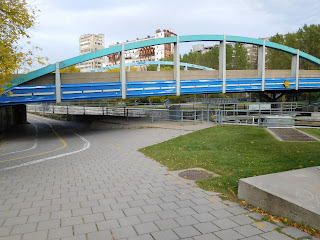I am generally not a fan of bike lanes. While data from Antwerp, Belgium indicate that they cut the accident rate in half on high-speed (75KPH/45MPH or more) roads, that same study shows that a cyclist riding in either a separated or painted lane along a medium-speed (50KPH, or 30 MPH) has roughly the same accident risk as one riding on the road itself.
The same research shows, most tellingly, that along low-speed roads (30KPH/20MPH)--meaning most urban streets--a cyclist in a painted lane is nearly five times as likely to get in an accident. And, if he or she is riding in a separated lane, the risk increases to more than six times what it would be if the road had no lane.
Studies from other locales corroborate the main lesson of Antwerp's experience: that bike lanes make cyclists safer only in comparison to riding on a highway. On most suburban streets, the safety level is about the same as it is for lanes. And on city streets, using bike lanes actually puts cyclists at greater risk for accidents than if they rode on sidewalks, which have long been considered--by planners and everyday cyclists alike--to be the most dangerous places to ride.
Yet transportation planners and "experts" insist that the best way to make urban cycling safer is to paint or install more lanes. When confronted with findings like the ones I've mentioned, their response usually goes along the lines of "Well, bike lanes make people feel safer. And if people feel cycling is safer, more of them will do it."
Some people feel safer if they sleep with a gun under their pillow. I wonder how well that logic works.
Anyway, it seems that in transportation planning--especially as it pertains to bicycles--there isn't an idea that's so bad that nobody can come up with something worse. And, sadly, those worse ideas are just as likely to come from "bike friendly" burgs as they are to emanate from those places where one is not considered fully human without an internal combustion engine.
For the past decade or so, Montreal has been done as much as any city to encourage cycling. Like other municipalities with "bike friendly" reputations, it established a bike-share program (Bixi) and turned disused byways like the path along the Lachine Canal into bike lanes. To be sure, it made some mistakes, but on the whole, Montreal has probably done more than most cities (at least in the Americas) to consider cyclists in its transportation planning.
But now it seems that Denis Corderre, the Mayor the City of a Hundred Steeples, plans to take one of the most unsafe practices of contemporary urban planning and make it even more hazardous for cyclists--and just about everyone else.
La Rue St. Denis and Le Boulevard St. Laurent are the two main north-south thoroughfares on the island of Montreal, while Sherbrooke Street is one of its major east-west conduits. Monsieur Corderrre wants to paint lanes on them that will be shared by bikes and buses.
Let that one sink in. Bikes and buses in the same lane. I don't see how anyone can feel, let alone be, safer. Buses have a lot of blind spots, so it's easier for a bus driver to simply not see a cyclist in the lane. Also, buses pulling over to pick up and discharge passengers, and pulling away from those bus stops are at least as much of a hazard as motorists making turns into intersections into which bike lanes feed.
Oh, but it gets worse. You see, Corderre's plan also calls for turning Avenues Papineau and de Lorimier--two other important north-south routes--into one-way streets simply to accomodate the bus/bike lanes.
When I visited the City of Saints last year, I spent a fair amount of time riding all of those streets. They are heavily trafficked, but one can ride them by exercising the same sort of caution one would employ on a major street in almost any western city. Even a separate bike-only lanes would probably do nothing to make cycling safer. In fact, they would most likely make riding more dangerous for the same reasons they put pedalers in greater peril in other cities. On those streets, as well as on streets in other cities in which I've cycled, it's easier and safer to negotiate with buses when they, and cyclists, are part of the regular traffic flow. I know: I do it nearly every day!
Denis Corderre, reconsiderez s'il vous plait!








































